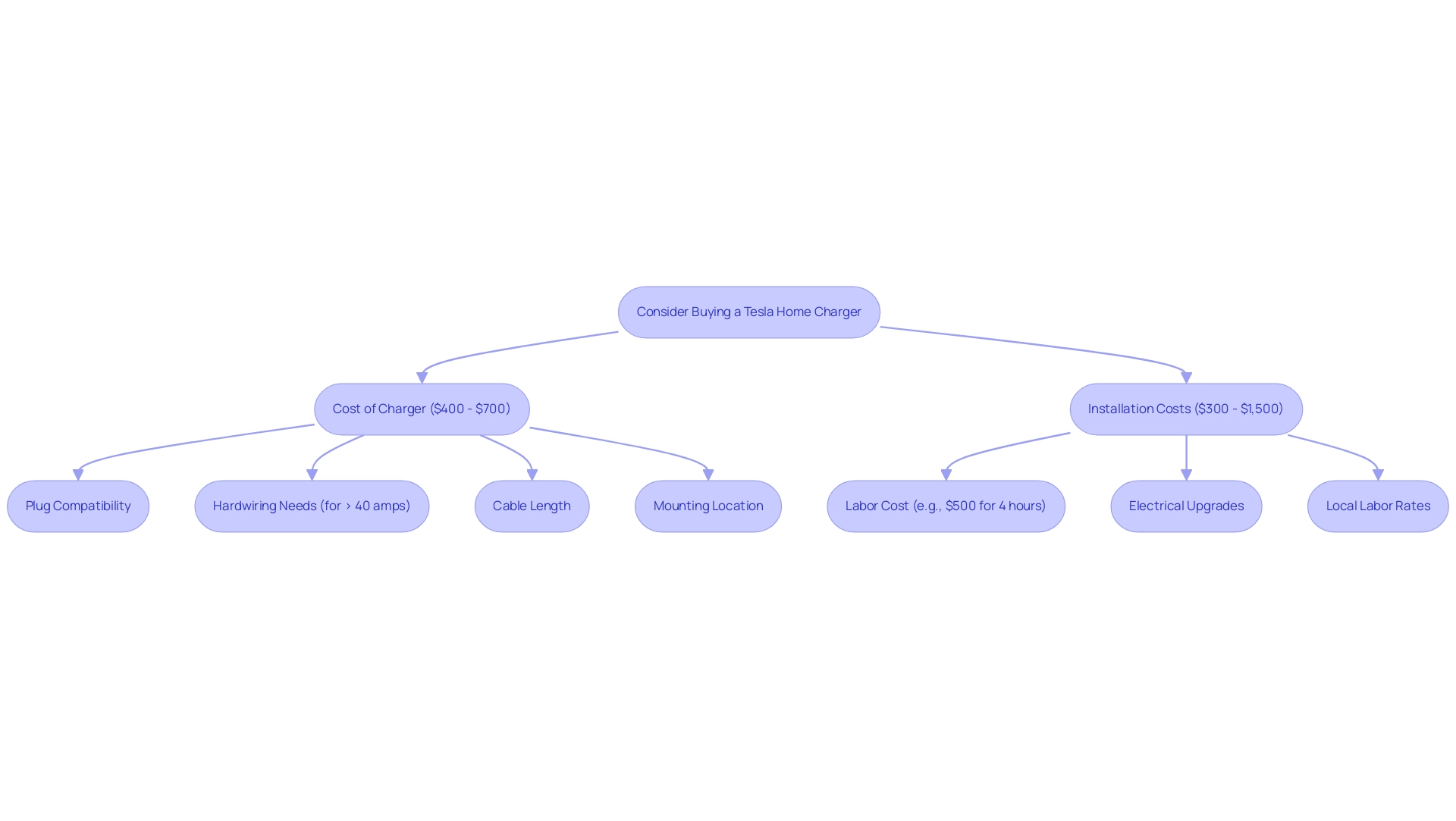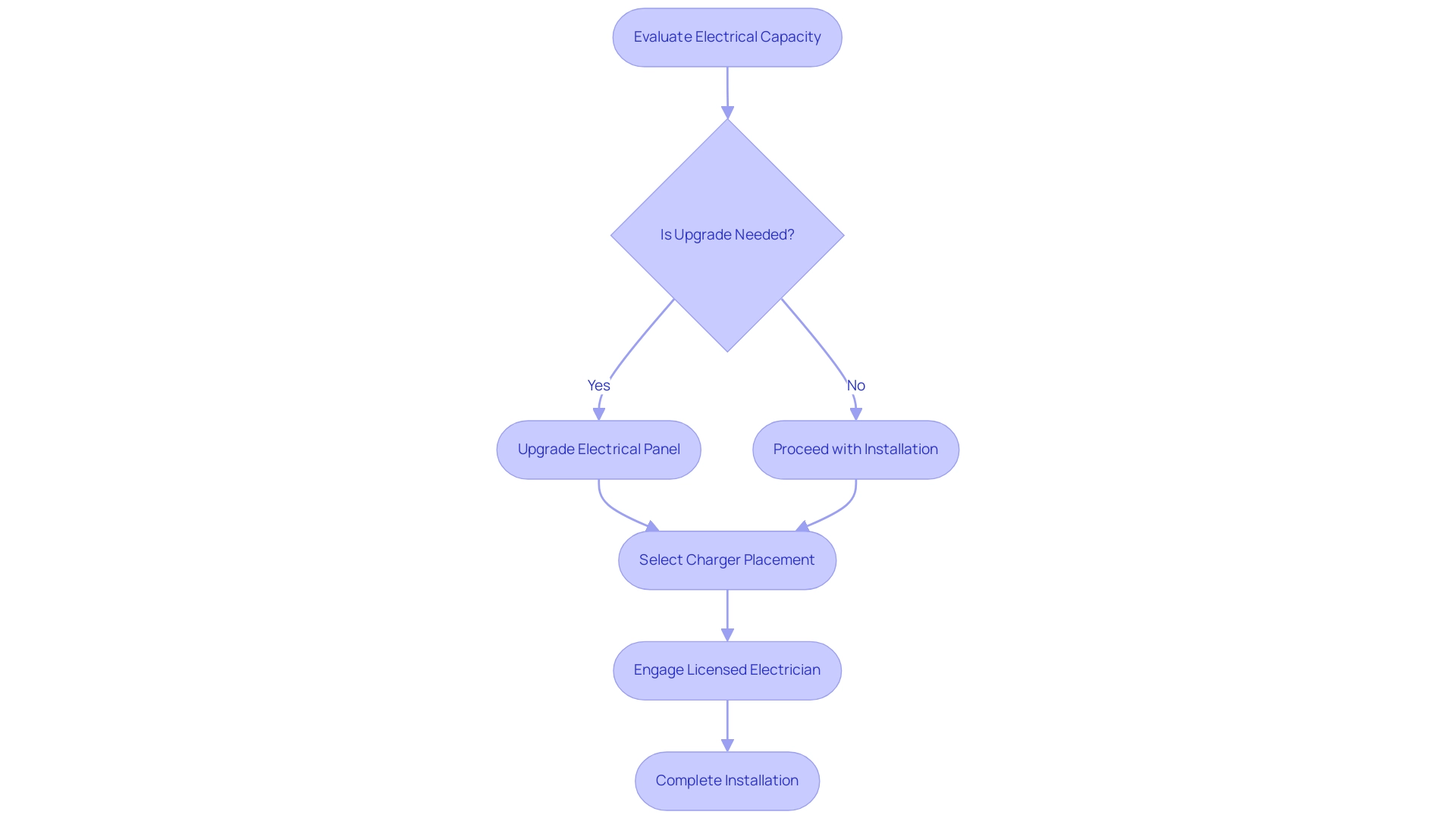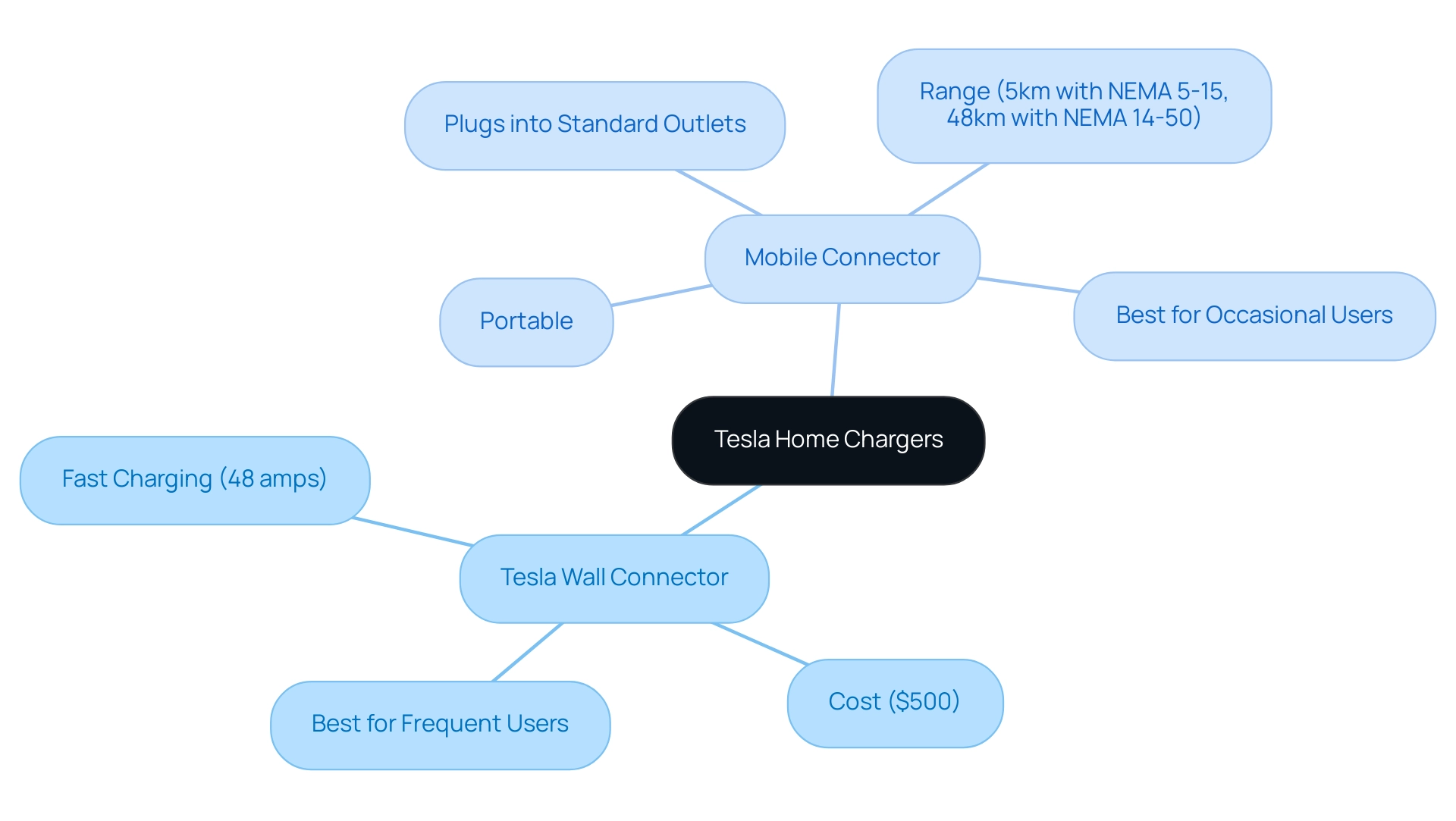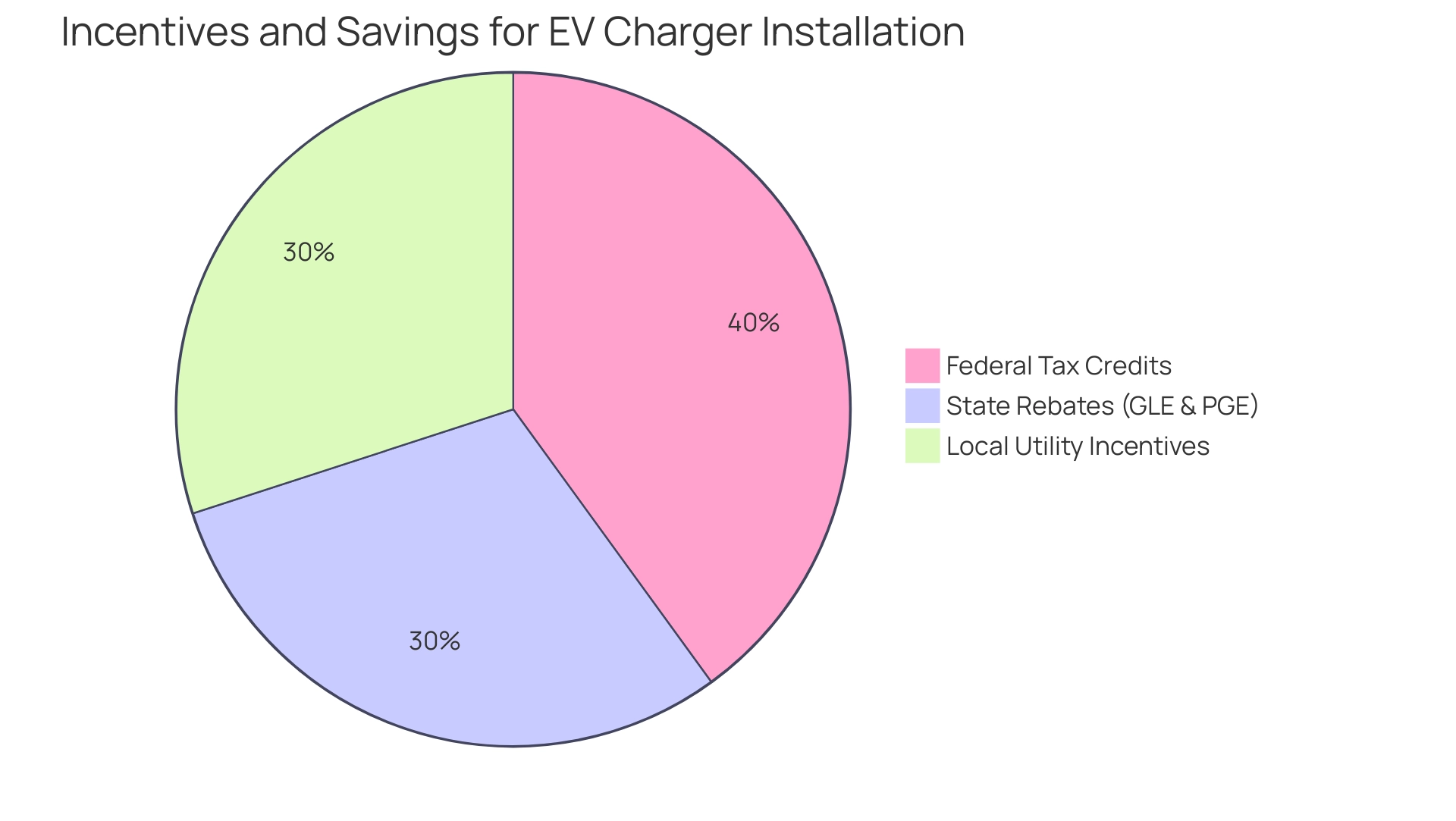Introduction
The transition to electric vehicles (EVs) is more than just a trend; it’s a pivotal step towards a sustainable future. For homeowners considering this shift, installing a Tesla home charger not only provides the convenience of at-home charging but also opens the door to significant cost savings over time.
However, navigating the various aspects of installation, from upfront costs to potential incentives, can feel overwhelming. This guide breaks down everything from:
- The types of chargers available
- Installation considerations
- The financial benefits
Ensuring that readers can make informed decisions that align with their energy needs and budget. Whether it’s understanding the initial investment or exploring ways to enhance energy efficiency with solar solutions, this article aims to empower homeowners to embrace the electric vehicle revolution confidently.
Understanding the Costs of Tesla Home Chargers
When considering how much is a home charger for a Tesla, you’ll find that the unit itself typically falls within the range of $400 to $700. However, understanding how much is a home charger for a Tesla is just the beginning of your investment. When considering how much is a home charger for a Tesla, it’s important to note that installation fees can significantly increase your total cost, usually ranging from $300 to $1,500.
For example, the labor cost for 4 hours of work can be around $500, highlighting potential installation expenses. Several factors contribute to this variability, such as the distance from your electrical distribution system and whether your home requires any electrical upgrades. Local labor rates also play a role, making it essential to gather multiple quotes from licensed electricians to ensure you’re receiving a fair deal.
As Tronguy points out, having a robust electrical system is crucial:
What I’m vaguely impressed by is the fact that you had a 200A panel that was full. 200A is a lot of current for a house…
This highlights the significance of professional evaluation when planning your EV charging setup.
Additionally, when choosing an EV charging station, it’s vital to consider factors such as:
- Plug compatibility
- Hardwiring needs for devices over 40 amps
- Cable length
- Mounting location
By assessing these elements, you can more effectively manage how much is a home charger for a Tesla when installing an electric vehicle charging station in your residence. Furthermore, the Tesla charger features advanced technology that helps keep electricity bills low, adjusting its charging rate based on available energy, making it a perfect choice for eco-conscious residents.
To boost your energy efficiency even more, think about incorporating solar systems into your residence configuration, which can be backed by government initiatives. Investigating choices for solar batteries can optimize your investment, while leading solar cleaning services guarantee your system’s efficiency, enabling you to gain the most from your eco-friendly solution.
Installation Costs and Considerations for Tesla Chargers
As you begin the process of installing your Tesla charging station, it’s essential to first evaluate your existing electrical capacity. If your residence has an old electrical system, you may discover that an upgrade is required to accommodate your new device. This investment not only enhances your system’s efficiency but also significantly reduces the risk of electrical fires.
As one electrician puts it,
You’ll greatly reduce the risk of electrical fires due to an overload, and your system will work more efficiently.
When considering how much is a home charger for a Tesla, it’s important to note that upgrading your electrical panel usually costs between $350–$500 for the panel alone and $1,800–$3,500 for the panel with installation. Additionally, consider where to place your charger—ideally, it should be easily accessible and close to your vehicle’s parking spot.
Recent case studies show that while 300-amp upgrades are less common, they are reserved for specific high-demand situations, providing a practical example of electrical upgrades. To navigate this process smoothly and ensure compliance with local codes, always engage a licensed electrician who specializes in EV charger installations. Our comprehensive services include:
- Accurate estimates
- Expert troubleshooting
- Thorough safety inspections tailored to your needs
Regular maintenance of your electrical systems is key to ensuring optimal performance, just as keeping your solar panels clean maximizes their efficiency. With the right preparation and professional support, including our installation services, you can enjoy the convenience of residential charging while maintaining safety and efficiency.
Exploring Different Types of Tesla Home Chargers
When it comes to Tesla residential power sources, you typically have two prominent choices: the Tesla Wall Connector and the Mobile Connector. Think of the Wall Connector as your reliable, permanent charging buddy. It delivers faster charging speeds, with a full 48 amps level 2 charging capability when one EV is full, making it perfect for those who need to juice up their vehicle daily.
The price for the Wall Connector, which answers the question of how much is a home charger for a Tesla, typically ranges around $500 and can be a worthwhile investment for frequent users. On the other hand, the Mobile Connector is like the trusty sidekick you can take anywhere. It plugs into standard outlets, making it an excellent choice for occasional users or those without a dedicated charging station.
However, using a wall outlet with mobile power sources may require additional devices and could present length issues for parking. For instance, with a NEMA 5-15 adapter, the Mobile Connector can add about 5 kilometers of range in just an hour—ideal for those quick top-ups. If you’ve got a NEMA 14-50 adapter, you’re looking at around 48 kilometers of range in the same timeframe!
Additionally, it has been suggested in forums to use a GFCI breaker for inspection purposes, which you can replace with the old breaker afterwards. This practical advice could help avoid GFI trouble. As you explore your choices, think about how Tesla charging stations integrate into the wider solar energy framework, including government initiatives that may provide rebates or incentives for setup, along with battery storage solutions that can improve your home’s efficiency.
So, assess your charging habits and needs:
- If you charge often, the Wall Connector might be your best bet;
- If you need flexibility, the Mobile Connector has you covered.
Incentives and Savings for Installing Tesla Chargers
Homeowners enthusiastic about adopting electric vehicle (EV) technology should be excited to learn that there are federal tax credits available that can considerably reduce the expenses of EV equipment. As Kelley R. Taylor, Senior Tax Editor at Kiplinger.com, notes, ‘Understanding the available tax credits and incentives can make a substantial difference in the overall cost of transitioning to electric vehicles.’ These credits typically cover a percentage of your expenses, making the transition to greener energy more affordable.
On top of that, many states have their own rebates and incentives that can further lighten the financial load. For example:
- GLE customers can take advantage of a $500 rebate specifically for the purchase and setup of a Level 2 EV device.
- Portland General Electric (PGE) customers have access to this same $500 rebate, alongside extra incentives for low-income households, encouraging more residents to install EV charging stations.
Retiree renters may also qualify for potential tax savings, which is an important consideration for this demographic. It’s always wise to check with your local utility company, as they may offer additional cash incentives for installing EV charging stations. For expert assistance with EV charging installation, contact Powercore Electric Inc. at ryan.serrano@powercoreinc.net or call (916) 699-8778.
And remember to stay updated on any changing regulations and programs that could enhance your savings—every little bit helps when making the switch to an electric vehicle!
Long-Term Financial Implications of Tesla Home Charging
Investing in a Tesla charger can significantly enhance your financial picture over time, especially when paired with solar energy solutions. One of the biggest perks is that charging your electric vehicle (EV) at your residence often proves to be much more economical than filling up with gasoline. For instance, in Washington state, drivers save up to 13.1 cents per mile on fuel, translating to about $120 a month.
With electricity prices generally remaining stable, homeowners can enjoy predictable charging costs, unlike the volatile prices at the pump. Additionally, government programs, such as tax credits and rebates, can further reduce the initial costs of solar installations, allowing you to maximize your savings. When combined with these incentives, you can lower your energy costs while making a positive impact on the environment.
Moreover, consider the added benefits of reduced maintenance expenses associated with electric vehicles. On average, EV owners experience maintenance costs of about $949 a year compared to $1,279 for gas-powered cars, resulting in annual savings of approximately $300. When you factor in these savings, it becomes clear how quickly your investment in a home charger for a Tesla can pay off, especially when considering how much is a home charger for a Tesla.
It’s also important to keep in mind that battery replacement may be needed after 8-10 years, although many EVs come with warranties lasting up to 10 years or 100,000 miles. Additionally, regular cleaning of solar panels is essential to maintain their efficiency, and many top solar panel cleaning services are available to assist homeowners. By switching to electric and considering solar energy options, you’re not just making an environmentally friendly choice—you’re also making a savvy financial decision that can benefit you for years to come.
Conclusion
Embracing the transition to electric vehicles is not just a step towards sustainability; it’s also an opportunity to enhance your financial well-being. Understanding the costs associated with installing a Tesla home charger is crucial, as it encompasses not only the price of the unit but also the installation expenses that can vary widely based on your home’s electrical capacity and local labor rates. By carefully assessing these factors, homeowners can make informed decisions that align with their needs.
Choosing the right type of charger is equally important. Whether it’s the robust Wall Connector for daily use or the versatile Mobile Connector for occasional charging, selecting the appropriate option can significantly impact convenience and efficiency. Additionally, taking advantage of available incentives and rebates can further ease the financial burden, making the transition to electric vehicles more accessible.
Ultimately, investing in a Tesla home charger, especially when paired with solar energy solutions, can lead to substantial long-term savings. With lower fuel costs, reduced maintenance expenses, and potential tax credits, the financial benefits are clear. As homeowners navigate this exciting shift, they are not only contributing to a greener future but also making a smart investment for their household. Now is the time to take charge of your energy needs and step confidently into the electric vehicle revolution.







